
A group of mature trees. The short, stocky tree on the left contains multiple clonal stems around a large-diameter "mother" tree, while the two trees on the right show the classical spire-shaped form; they are ca. 20 m tall. Pictured Rocks National Lakeshore, Michigan [C.J. Earle, 2019.10.04].

Stunted tree near timberline, Mt. Katahdin, Maine [C.J. Earle, 2003.07.15].

Balsam fir foliage and disintegrating cones, Keweenaw Peninsula, Michigan [C.J. Earle, 2019.10.02].
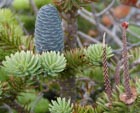
Foliage, cone and rachides on a krummholz tree; the cone is near maturity and the leaves are typical of Abies sun foliage. Mt. Katahdin, Maine [C.J. Earle, 2003.07.15].
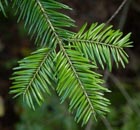
Typical shade foliage on a forest interior tree, Door Peninsula, Wisconsin [C.J. Earle, 2019.10.06].
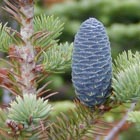
Cone on a krummholz tree on Mt. Katahdin, Maine [C.J. Earle, 2003.07.15].
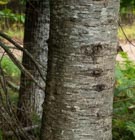
Bark on small trees (this about 20 cm diameter) is dark gray with resin blisters. Au Train, Michigan [C.J. Earle, 2019.10.04].

Bark on large trees (this about 80 cm diameter) is gray, scaly, finely fissured; this tree also has many branches dating from its youth as an open-grown tree. Pictured Rocks National Lakeshore, Michigan [C.J. Earle, 2019.10.04].
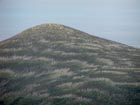
Fir waves on The Brothers, Baxter State Park, Maine. See text for discussion [C.J. Earle, 2003.07.15].

Riparian fringe of A. balsamea and Picea glauca with emergent Pinus strobus behind; Lake Itasca State Park, Minnesota [C.J. Earle, 2019.09.29].

Pure stands on wet soils are commonly dense, dark, depauperate, and may occur on peatlands or mixed with Larix laricina and/or Picea mariana. Lake Itasca State Park, Minnesota [C.J. Earle, 2019.09.29].
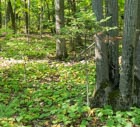
This sapling in the understory of a Laurentian hardwood forest shows typical "advance regeneration" morphology with very slow apical growth and a crown of flat branches bearing sparse shade foliage. Ellison Bluff, Door Peninsula, Wisconsin [C.J. Earle, 2019.10.07].
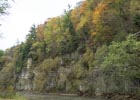
Bluffton, Iowa hosts the southwesternmost occurrence of A. balsamea; the trees here grow on an extremely steep north-facing slope above a river, in the company of Pinus strobus and understory Taxus canadensis [C.J. Earle, 2019.10.11].

Conservation Status

Abies balsamea
(Linnaeus) Miller 1768
Common names
Balsam, balsam fir, blister fir, balm-of-Gilead fir, Canada balsam; sapin baumler [French]; zhingob [Ojibwe]; Pohpóhkhαwih [Penobscot]; Puhpukhawihqimus [Passamaquoddy-Maliseet]; Stoqon [Micmac].
Taxonomic notes
A. balsamea shares a clade with A. fraseri, sister to A. lasiocarpa (Semerikova and Semerikov 2016); indeed, A. fraseri is better described as a subspecies or variety of A. balsamea (Potter et al. 2010), though this idea has not yet acquired wide currency (see A. fraseri for a detailed discussion). Consequently the variety Abies balsamea (L.) Mill. var. phanerolepis Fernald 1909, described as intermediate between A. fraseri and A. balsamea, has little taxonomic significance.
Synonymy:
- Pinus balsamea Linnaeus 1753;
- Abies balsamea (L.) Mill. var. phanerolepis Fernald 1909;
- Abies intermedia Fulling 1936;
- Abies balsamea (L.) Mill. f. phanerolepis (Fernald) Rehd. 1940;
- Abies ×phanerolepis (Fernald) T.S. Liu 1971; and
- Abies balsamea (L.) Mill. subsp. phanerolepis (Fernald) E. Murray 1982.
Populations west of Ontario lack 3-carene and have other minor chemical differences separating them from eastern balsam fir (Hunt 1993). "In Alberta, populations intermediate between Abies balsamea and may be classified as A. balsamea × bifolia" (Hunt 1993).
Description
A narrowly conical tree 12-23 m tall, 10-60 cm dbh, with a spire-like crown. Bark gray, thin, smooth, in age often becoming broken into irregular brownish scales. Branches diverging from trunk at right angles, the lower often spreading and drooping. Twigs mostly opposite, finely pubescent, yellow grey-brown or green-brown. Buds hidden by leaves or exposed, brown to reddish-purple, conic to globose, scales slightly pubescent, 9-11 mm in diameter, resinous, apex acute; basal scales short, broad, nearly equilaterally triangular, glabrous, resinous, margins entire, apex sharp-pointed. Needles 1-ranked (particularly on lower branches) to spiraled, curved upwards on branchlets exposed to full sun; cross section flat, grooved above, keeled below, shiny dark green above, 12-25 mm long by 1.5-2 mm wide, green or grey-green below; stomata in 0-4 rows at midleaf above, these more numerous toward leaf apex, with (4-)6-7(-8) stomatal rows on each side of midrib below; base twisted; odor pinelike (copious ß-pinene); apex slightly notched to pointed; resin canals large, ± median, away from margins, midway between abaxial and adaxial epidermal layers. Male cones 15mm long, at pollination red, purplish, bluish, greenish, or orange. Female cone resinous, sessile, apex round to obtuse, cylindric to broadly ovoid, 4-10 cm long by 1.5-3.75 cm wide, blue-grey-green or purple turning grey-brown or violet-brown; scales scales ca. 1-l.5 × 0.7-1.7cm (relationship reversed in more western collections), finely pubescent; bracts included or exserted and reflexed over scales. Seeds triangular, 3-6 × 2-3mm, body brown; wing about twice as long as body, brown-purple; cotyledons ca. 4. 2n=24 (Silba 1986, Hunt 1993). See García Esteban et al. (2004) for a detailed characterization of the wood anatomy.
Distribution and Ecology
Canada: Alberta, Saskatchewan; Manitoba, Ontario, Québec, Prince Edward Island, New Brunswick, Nova Scotia, Newfoundland; France: St. Pierre and Miquelon; USA: Minnesota, Michigan, Wisconsin, Iowa, West Virginia, Virginia, Pennsylvania, New York, Connecticut, Massachusetts, Vermont, New Hampshire, and Maine at 0-1700 m elevation in boreal and north temperate forests (Hunt 1993). See also Thompson et al. (1999). Hardy to Zone 2 (cold hardiness limit between -45.6°C and -40.0°C) (Bannister and Neuner 2001).
Distribution data from USGS (1999).
A. balsamea has a wide ecological amplitude. I have seen it growing in forested peatlands, seasonal wetlands, riparian areas, oldfields, the understory of upland hardwood forests, cliffs, and subalpine and alpine sites, on both silicic and carbonate substrates. Besides occurring with a wide variety of angiosperm trees, it can be found in association with Pinus strobus, P. resinosa, P. banksiana, Picea glauca, P. mariana, Larix laricina, Thuja occidentalis, Juniperus virginana, J. communis, J. horizontalis, and Taxus canadensis. It is early successional in oldfields, but is also the most shade-tolerant of the conifers just listed. Like its close relative A. lasiocarpa, it often forms clumps, where branches from an older central stem have layered, developed apical dominance, and assumed arboreal growth within a clone; and, like A. lasiocarpa, this often happens in exposed areas where heavy snowfall or cold, wet soils make seedling establishment difficult and grant a competitive advantage to clonal reproduction.
Like most firs, A. balsamea is generally intolerant of fire. Ali et al. (2008) documented decline in western Quebec A. balsamea that occurred between the mid-Holocene (7,000 to 3,500 years BP) and the present, in response to increases in fire frequency and severity. This intolerance to fire influences the competitive balance between A. balsamea and the spruces (Picea glauca and P. mariana), which share a similar ecological role but are much more fire-adapted.
This species is host to one of the most curious phenomena in forest ecology: the fir wave, a cyclic disturbance-regeneration cycle in which the death of overstory trees produces sunlight and warmth on the forest floor, allowing seedling regeneration. Once the seedlings become canopy dominant trees (about 60 years later), darkness, cold, and poor nutrient availability cause the death of the overstory trees. This cycle produces waves of growing, dying and dead trees that sweep across the landscape, as shown in the image here, taken at Baxter State Park, Maine. The phenomenon has also been recorded in the Adirondack Mountains of New York and the White Mountains of New Hampshire (Sprugel and Bormann 1981).
Remarkable Specimens
The largest specimen in the U.S.A. is 129 cm dbh with a height of 31.7 m (2018 measurement); it has been the champion since 1992, and grows in Adams County, Pennsylvania (Payne 2025).
The oldest record is from a tree-ring chronology covering 245 years, presumably based on living tree material, collected in 1996 at Lac Liberal, Canada (470 m elevation, 49.06667°N, 72.10000°W) by C. Krause and H. Morin (NOAA 1999).
Ethnobotany
The balsam fir has long been a popular choice for Christmas trees in eastern North America, and is widely farmed for that purpose. It has been a popular selection for the U.S. Capitol Christmas tree, being used 6 times (as of 2024) since the tradition began in 1964, with trees mostly sourced from Vermont. The primary economic uses are for dimensional lumber and pulp. There are also a wide variety of nontimber uses, including holiday decoration (wreaths, garlands, floral displays); scented ornamental pillows and incense (both using ground needles and twigs); and resins. The resin, commercially known as "Canada balsam", historically had various industrial uses such as cementing cover slips on microscope slides and cementing the elements of compound lenses. The resin also has a very long history of medicinal use, both by aboriginal peoples and today in naturopathic medicine (Fuller 2015). The Ojibwe used the resin to seal the seams of birchbark canoes, but also used it to treat sore eyes, for colds, and to heal sores. The leaves would be placed on live coals and inhaled to treat colds, or used in a sweat bath (similar to a sauna) (Smith 1932). Modern research has confirmed that the resin has some antibacterial properties (Coté et al. 2016).
Many dendrochronology studies have looked at stand dynamics from various perspectives: postfire recovery, disturbance response, fir wave dynamics, beaver pond impacts, stand growth and yield models. Growth declines have been studied in the context of gamma radiation exposure, heavy metal contamination, and atmospheric acid/nitrate deposition. Spruce budworm impacts have been studied extensively, some work has been done on the species' occurrence at timberlines, and there are some ecophysiology studies. Perhaps the oddest study is one relating tree growth to fluctuations in wolf and moose populations on Isle Royale in Lake Superior: balsam fir is foraged by moose; the moose eat the fir foliage; the fir declines as the moose population grows; the wolf population grows and depletes the moose; and the fir proliferates. Time lags in the response of each species drive the cycle (McLaren and Peterson 1994).
Observations
The species is quite common within its range, occurring in mixed hardwood and conifer forest as well as in pure stands. I can particularly recommend occurrences at Lake Itasca State Park in Minnesota, locations all along the shore of Lake Superior, and the Door Peninsula of Wisconsin; in these areas relatively pristine forest has been preserved in parks and natural areas, and the species can be seen in association with various other conifers, in a wide variety of ecological settings. I can also recommend the high mountains of New Hampshire and Maine, where krummholz trees can be found growing at the alpine timberline.
Remarks
The epithet balsamea refers to the sap resin, balsam.
Balsam fir is the provincial tree of New Brunswick (Hunt 1993).
This is one of the most cold-hardy trees known; specimens prehardened to subfreezing temperatures showed no adverse effects from immersion in liquid nitrogen (-196°C) (Sakai and Weiser 1973).
Citations
Ali, A. A., H. Asselin, A. C. Larouche, Y. Bergeron, C. Carcaillet, and P. J. H. Richard. 2008. Changes in fire regime explain the Holocene rise and fall of Abies balsamea in the coniferous forests of western Québec, Canada. The Holocene 18(5):693-703.
Coté, H., M. A. Boucher, A. Pichette, B. Roger, and J. Legault. 2016. New antibacterial hydrophobic assay reveals Abies balsamea oleoresin activity against Staphylococcus aureus and MRSA. Journal of Ethnopharmacology 194:684-9.
Fuller, D. 2015. Bulletin #2541, Non-Timber Forest Products: Goods from the Maine Woods: Maine Balsam Fir: A Tree of Many Uses, Abies balsamea. University of Maine Cooperative Extension, Orono, Maine. Available: https://extension.umaine.edu/publications/2541e/, accessed 2020.01.17.
McLaren, B. E. and R. O. Peterson. 1994. Wolves, Moose, and Tree Rings on Isle Royale. Science 266(5190):1555-1558.
Miller, P. 1768. The Gardeners Dictionary, 8th edition. London. [No pagination]. Available: Biodiversity Heritage Library, accessed 2020.01.17.
[NOAA 1999] Data accessed at the NOAA Paleoclimatology Program Tree-Ring Data Search Page. http://julius.ngdc.noaa.gov/paleo/ftp-treering.html, accessed 1999.02.24, now defunct.
Payne, J. (ed.). 2025. The 2024 Register of National Champion Trees. National Champion Tree Program, https://nationalchampiontree.org/.
Potter, K. M., J. Frampton, S. A. Josserand, and C. Dana Nelson. 2010. Evolutionary history of two endemic Appalachian conifers revealed using microsatellite markers. Conservation Genetics 11(4):1499–1513.
Sakai, A. and C. J. Weiser. 1973. Freezing resistance of trees in North America with reference to tree regions. Ecology 54:118–126.
Semerikova, S. A., and V. L. Semerikov. 2016. Phylogeny of firs (genus Abies, Pinaceae) based on multilocus nuclear markers (AFLP). Russian Journal of Genetics 52(11):1164–1175.
Smith, H. H. 1932. Ethnobotany of the Ojibwe Indians. Bulletin of the Public Museum of the City of Milwaukee 4(3):327-525.
Sprugel, D. G., and F. Bormann. 1981. Natural disturbance and the steady state in high-altitude balsam fir forests. Science 211(4480):390–393.
See also
Clark, C. M., T. R. Wentworth, and D. M. O'Malley. 2000. Genetic discontinuity revealed by chloroplast microsatellites in eastern North American Abies (Pinaceae). American Journal of Botany 87(6):774-782.
Elwes and Henry 1906-1913 at the Biodiversity Heritage Library. This series of volumes, privately printed, provides some of the most engaging descriptions of conifers ever published. Although they only treat species cultivated in the U.K. and Ireland, and the taxonomy is a bit dated, still these accounts are thorough, treating such topics as species description, range, varieties, exceptionally old or tall specimens, remarkable trees, and cultivation. Despite being over a century old, they are generally accurate, and are illustrated with some remarkable photographs and lithographs.
Farjon, Aljos. 1990. Pinaceae: drawings and descriptions of the genera Abies, Cedrus, Pseudolarix, Keteleeria, Nothotsuga, Tsuga, Cathaya, Pseudotsuga, Larix and Picea. Königstein: Koeltz Scientific Books.
- Provides a detailed account, with illustrations.
The FEIS database.
Lester, D. T. 1968. Variation in cone morphology of balsam fir, Abies balsamea. Rhodora 70:83-94.
Morris, R. F. 1948. How old is a balsam fir? The Forestry Chronicle 24:106-110.
Prasad and Iverson 1999.
Seymour, Robert S. 1995. Northeastern spruce-fir forests. In Status and Trends of the Nation's Biological Resources. USGS electronic publication. http://biology.usgs.gov/s+t/SNT/noframe/ne121.htm, accessed 2002.09.03, now defunct.













